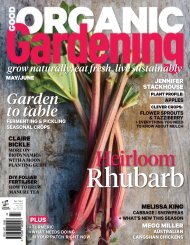1. Good Organic Gardening - January-February 2016
1. Good Organic Gardening - January-February 2016
1. Good Organic Gardening - January-February 2016
Create successful ePaper yourself
Turn your PDF publications into a flip-book with our unique Google optimized e-Paper software.
GARDENING CHALLENGE | Growing truffles<br />
White truffles<br />
Fresh Australian truffles reach the lucrative European markets<br />
when local produce is unavailable, which makes our truffles<br />
highly desirable.<br />
As well as being slow to produce, truffles need many months<br />
to develop and ripen. The part that’s eaten begins to grow in<br />
spring, developing from a tiny hollow cup into a dark warty<br />
lump, which becomes black with white veins. They grow in the<br />
soil, usually at a depth of about 15cm but sometimes more than<br />
30cm deep.<br />
Truffles have a rich, earthy fungus smell, which helps in<br />
locating them beneath the soil surface when they are ready to<br />
harvest. Pigs traditionally feasted on truffles growing wild in<br />
forests and were used to find wild truffles. Today, specially trained<br />
dogs are used to find truffles in commercial truffle farms.<br />
Backyard truffles<br />
Truffle growing ranges from large plantings on farms to smaller<br />
plantings on hobby farms. And, yes, even home growers are starting<br />
to give it a go. Trees inoculated with truffle spore are available<br />
occasionally at garden centres and in the plant section of large<br />
hardware outlets.<br />
Fred Hardin from the Australian Truffle Growers Association<br />
says that right now truffles aren’t likely to be a successful part of<br />
a productive suburban backyard but adds that things may change.<br />
“Truffles have very particular growing needs, including needing the<br />
right soil pH, which means adding lots of lime to most Australian soils<br />
and pruning the tree to encourage root growth, and they take time,” Fred<br />
explains. “But that doesn’t mean things won’t change in the future.”<br />
Things are also changing for both commercial producers and hobbyists<br />
considering truffle growing as there is now the possibility of buying and<br />
planting certified trees, making production less of a hit-and-miss affair.<br />
“There is a certification system operating in Australia<br />
to certify that trees inoculated with truffle spores<br />
are going to produce truffles,” Fred says. “There are<br />
two Australian growers offering certified trees to<br />
commercial growers and we hope others will follow.”<br />
Marcos Morcillo, a truffle grower in Spain,<br />
has just published Truffle Farming Today,<br />
a comprehensive guide to truffle growing<br />
with examples and experiences from<br />
around the world. In his book, Marcos is<br />
positive about the future of truffle farming<br />
as more plantations are planted, more scientific<br />
research is carried out and more is known about<br />
these curious edible fungi. He even suggests that<br />
one day there may be the possibility of a bonsai truffle<br />
tree for the backyard. Truffle lovers stand by!<br />
Is truffle growing for you?<br />
Still keen, despite the difficulties? If you live in a suitable climate with<br />
cold winters and mild summers, have good rich, well-drained soil<br />
and are up for the challenge of raising truffles in your own backyard<br />
trufferie, look for inoculated trees that are certified, or purchase from a<br />
local commercial grower who retails to the public.<br />
When preparing the ground for planting it’s important to<br />
amend your planting soil to raise the pH to around 8 by adding<br />
lime. Give the trees plenty of space to grow as well as extra care to<br />
encourage each tree to form a strong and vigorous root system.<br />
This care includes regular watering, especially if summers<br />
are dry. Then be patient, as truffles take many years to form.<br />
If all else fails, you’ll have grown some shady trees in your<br />
garden and made the world a better place!<br />
English oak<br />
More<br />
information<br />
For further information on truffle<br />
growing, contact the Australian<br />
Truffle Growers Association at<br />
trufflegrowers.com.au. For more<br />
on Marcos Morcillo’s trufflegrowing<br />
advice or to buy his<br />
book, see his website micofora.<br />
com or follow his blog at<br />
trufflefarming.wordpress.com.<br />
Shutterstock<br />
52 | <strong>Good</strong> <strong>Organic</strong> <strong>Gardening</strong>
















